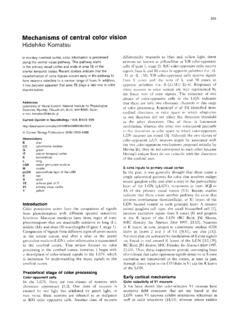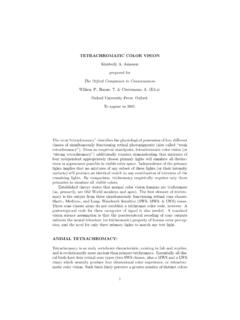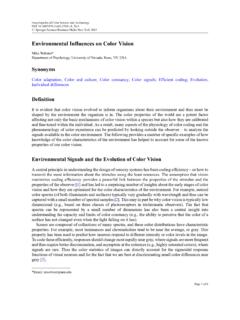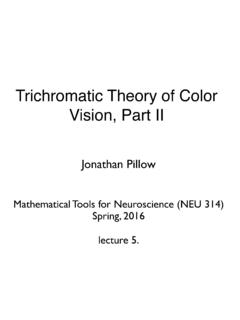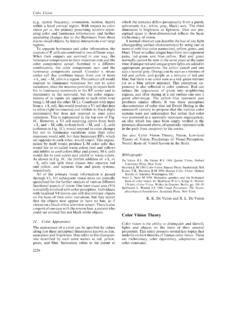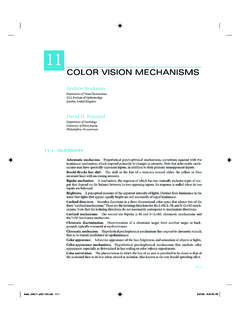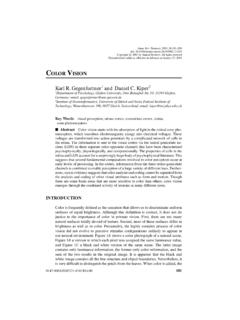Transcription of The Evolution of Primate Color Vision - Occidental College
1 56 Scientific AmericAn April 2009 Geoffrey Clements Corbis (painting); BoB elsdale Corbis (chimps); luCy re adinG-ik k anda (photoillustration)To our eyes, the world is arrayed in a seemingly infinite splendor of hues, from the sunny orange of a marigold flower to the gunmetal gray of an automobile chassis, from the buoyant blue of a midwinter sk y to t he spa rk l i ng g re en of a n emera ld. It is re-markable, then, that for most human beings any Color can be reproduced by mixing together just three fixed wavelengths of light at certain inten-sities. This property of human Vision , called t r i c h ro m a c y, a r i s e s b e c au s e t h e r e t i n a the layer of nerve cells in the eye that captures light and transmits visual information to the brain uses on ly t h ree t y pes of l ig ht-absorbi ng pig ments for Color Vision .
2 One consequence of trichromacy is that computer and television displays can mix red, green and blue pixels to generate what we perceive as a full spectrum of lt hou g h t r i c h ro m a c y i s c o m m o n a m o n g p r i-mates, it is not universal in the animal kingdom. Almost all nonprimate mammals are dichro-mats, with Color Vision based on just two kinds of visual pigments. A few nocturnal mammals have only one pigment. Some birds, fish and rep-tiles have four visual pigments and can detect ultraviolet light invisible to humans. It seems, then, that Primate trichromacy is unusual. How did it evolve? Building on decades of study, re-cent investigations into the genetics, molecular biology and neurophysiology of Primate Color Vision have yielded some unexpected answers as well as surprising findings about the flexibility of the Primate and Their PastThe spectral sensitivities of the three visual pig-ments responsible for human Color Vision were first measured more than 50 years ago and are now known with great precision.
3 Each absorbs light from a particular region of the spectrum and is characterized by the wavelength it absorbs most efficiently. The short-wavelength (S) pig-ment absorbs light maximally at wavelengths of about 430 nanometers (a nanometer is one bil-lionth of a meter), the medium-wavelength (M) pigment maximally absorbs light at approxi-mately 530 nanometers, and the long-wavelength (L) pigment absorbs light maximally at 560 nanometers. (For context, wavelengths of 470, 520 and 580 nanometers correspond to hues that the typical human perceives as blue, green and yellow, respectively.) These pigments, each consisting of a protein complexed with a light-absorbing compound derived from vitamin A, sit in the membranes of cone cells: photoreceptive nerve cells in the retina named for their tapering shape.
4 When a pigment absorbs light, it triggers a cascade of molecular events that leads to the excitation of the cone cell. This excitation, in turn, activates other retinal neurons that ultimately convey Key conceptS Loiametum dolore ting Lumsandio cor ad Bor in utatum vulput wisi eum eu feum quam. Equat acipit, vullaoreet irit lorpercin henisismodit ulputem ipit nonsequ isis-ci eriliquat. Um zzriurem vulputatet praesse magna consequis nit diatiscidui eum eu quam, quipis nosto odi-ametum dolore ting eum-sandio cor ad dolore del ullutat dolor tio euis ac-cumsandit, conse feu fac-cummy nia. The Editorse v o l u t i o nKey conceptSThe Color Vision of humans and some other primates differs from that of nonprimate is called trichromacy, because it depends on three t ypes of light- activated pigments in the retina of the of the genes for those pigments give clues to how trichromacy evolved from the Color Vision of nonprimate mam-mals, which have only two kinds of photo authors created trichromatic mice by insert-ing a human pigment gene into the mouse genome.
5 The experiment revealed unexpected plasticity in the mammalian brain. The EditorsThe Evolution of Primate Color VisionAnalyses of Primate visual pigments show that our Color Vision evolved in an unusual way and that the brain is more adaptable than generally thought By Gerald H. Jacobs and Jeremy Nathans CHIMPANZEES, like humans, can distinguish among colors that other mammals cannot see. What observers see in a Kandinsky reflects the properties of the paints, the nature of the illumi-nation, and the Color Vision system of the viewers. 2009 SCIENTIFIC AMERICAN, Scientific AmericAn 57 2009 SCIENTIFIC AMERICAN, Scientific AmericAn April 2009andre w swif t (retina illustrations); Courtesy of Ger ald H. JaCoBs (Jacobs); Courtesy of JoHns Hopk ins universit y (Nathans)A known mechanism for gene duplications of this type occurs during the formation of eggs and sperm.
6 As cells that give rise to eggs and sperm divide, pairs of chromosomes often swap parts in a process called recombination, and oc-c a s io n a l ly a n u n e qu a l e xc h a n g e of g e n e t i c m at e-rial leads to the production of a chromosome that possesses extra copies of one or more genes. Useful mutations subsequently introduced in those duplicate genes can then be maintained by natural selection. That is, by aiding survival, helpful mutations get passed down to future gen-erations and spread within the population. I n t h e c a s e of p r i m at e c olo r v i s io n , t r i c h ro m a-cy based on the new M and L pigments (along with the S pigment) presumably conferred a se-lective advantage over dichromats in some envi-ronments. The colors of ripe fruit, for example, frequently contrast with the surrounding foli-a g e , but d i c h ro m at s a r e l e s s abl e to s e e s u c h c o n-trast because they have low sensitivity to Color differences in the red, yellow and green regions of the visual spectrum.
7 An improved ability to identify edible fruit would likely aid the survival of individuals harboring the mutations that con-fer trichromacy and lead to the spread of those mutant genes in the population. The mechanisms outlined earlier gene du-plication followed by mutation leading to DNA sequence divergence would seem to be a rea-sonable ex pla nation for t he Evolution of t he pri-[T HE AuTHorS]Gerald H. Jacobs is research professor in the department of psychology and the Neuroscience research Institute at the universit y of California, Santa Barbara. The author of more than 200 articles and book chapters on the visual system, he deciphered the genetic mechanism that gives rise to trichromatic Color Vision in New World primates. Jeremy Nathans, who worked out the genetic sequences of the human visual pigment genes and the structure of the corresponding proteins, is professor in the departments of molecular biology and genetics, neuroscience and ophthalmology at the Johns Hopkins universit y School of Medicine and an investi-gator at the Howard Hughes Medical Institute.
8 LightOptic nerve to brain RETINAConeRodRetina rETINA, a layer of nerve cells at the back of the eye, transmits visual information to the brain via the optic nerve. Color Vision depends on cones: tapered sensory cells that contain light-activated pigments. other light-sensitive cells called rods function in dim light and do not usually participate in Color Vision . The rods and cones, known collec-tively as photoreceptors, sit behind other cell types that support Vision . a signal along the optic nerve to the brain. Although the absorption spectra of the cone pigments have long been known, it was not until t h e 198 0 s t h at o n e of u s ( N at h a n s) id e nt i fi e d t h e genes for the human pigments and, from the DNA sequences of those genes, determined the sequence of amino acids that constitutes each pigment protein.
9 The gene sequences revealed that the M and L pigments are almost identical. Subsequent experiments showed that the differ-ence in spectral sensitivity between them derives from substitutions in just three of the 364 amino acids from which each is built. Experiments also showed that the M- and L-pigment genes sit next to each other on the X chromosome, one of the two sex chromosomes. (Men have one X and one Y, whereas women have two Xs.) This location came as no surprise, because a common anomaly in human Color per-ception, red-green Color blindness, had long been k now n to o c c u r m o r e of t e n i n m e n t h a n i n wo m-en and to be inherited in a pattern indicating that the responsible genes reside on the X chromo-some. The S-pigment gene, in contrast, is located on chromosome 7, and its sequence shows that the encoded S pigment is related only distantly to the M and L the mid-1990s comparisons of these three pigment genes with those of other animals had provided substantial information about their history.
10 Almost all vertebrates have genes with sequence s t hat a re ver y si m i la r to t hat of t he hu-man S pigment, implying that some version of a shorter-wavelength pigment is an ancient ele-m e nt of c olo r v i s io n . R e l at ive s of t h e t wo lo n g e r -wavelength pigments (M and L) are also wide-spread among vertebrates and likely to be quite ancient. But among mammals, the presence of both M- and L-like pigments has been seen only in a subset of Primate species a sign that this feature probably evolved more recently. Most nonprimate mammals have only one longer-wavelength pigment, which is similar to the longer-wavelength Primate pigments. The gene for the longer-wavelength mammalian pigment is also located on the X chromosome. Those features raised the possibility, then, that the two longer-wavelength Primate pigment genes first arose in the early Primate lineage in this way: a longer-wavelength mammalian pig-m e nt g e n e wa s dupl i c at e d o n a s i n g l e X c h ro m o-some, after which mutations in either or both copies of the X-linked ancestral gene produced t wo qu it e s i m i l a r p i g m e nt s w it h d i f f e r e nt r a n g e s of spectral sensitivity the M and L pigments.











